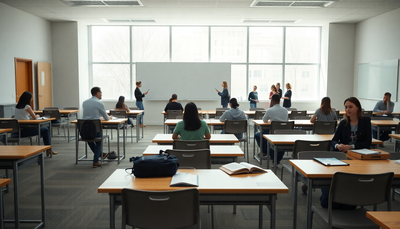
Higher education in the United States is at a crossroads, as an increasing number of students and families question the value of a college degree. Rising tuition fees, heavy student debt burdens, and diminishing returns on investment are pushing many 18-year-olds to explore alternative career paths. This shift has led to a significant decline in college enrollments and a growing wave of institutional closures: A federal report projecting nearly 80 colleges across the US can close their doors in the next five years.
Declining enrollment reflects a waning trust in higher education
Between the fall of 2023 and the fall of 2024, enrollment of 18-year-old freshmen in public and private, nonprofit four-year colleges fell by more than 6 percent, according to data from the
National College Attainment Network
and the National Student Clearinghouse Research Center. This drop, reflecting a sample of 80 percent of national enrollments, highlights a generational shift in attitudes toward traditional higher education.
Demographic changes have also played a role. White students experienced the steepest enrollment declines, with a 10 percent drop compared to the previous year. Among highly selective institutions, enrollment of Black, Multiracial, and Hispanic students fell even more sharply, with Black freshmen numbers plummeting nearly 20 percent at selective public universities. This data underscores the growing disillusionment with the perceived value of a degree, particularly among historically underrepresented groups.
Rising costs and shifting perceptions of value
Despite some improvements in financial aid and a slight decline in inflation-adjusted tuition costs, the long-term trajectory of college affordability remains troubling. According to the Education Data Initiative, the average annual tuition for public four-year colleges rose from $3,501 in 2001 to $9,750 in 2023, the New York Sun reported. For private colleges, the increase was even more dramatic, soaring from $15,470 to $35,248 over the same period. These rising costs have outpaced inflation significantly, making higher education less accessible to many families.
A 2024 survey by College Ave revealed that only 44 percent of parents felt financially prepared to pay their child’s first tuition bill. Combined with the high rates of graduates working in jobs that do not require a degree, a figure reported as 45 percent a decade after graduation, students and families are increasingly questioning whether the investment is worth it.
The enrollment cliff and its impact
The challenges facing higher education are compounded by demographic shifts. Declining birth rates in the United States, which hit a historic low in 2024, are expected to exacerbate enrollment declines beginning in 2025. Known as the “enrollment cliff,” this phenomenon reflects the long-term impact of fewer young people entering the college-age population.
This demographic pressure has contributed to a surge in college closures. According to the State Higher Education Executive Officers Association, more than 500 private, nonprofit four-year colleges have closed in the last decade, a threefold increase compared to the previous decade. In 2024 alone, an average of one college or university shut down each week.
Alternative pathways gain momentum
Amid declining enrollments, community colleges and trade schools have seen a resurgence in popularity. Institutions offering technical education and training for in-demand professions, such as welding, have experienced smaller enrollment declines and even recovery from pandemic-era lows. These programs are increasingly viewed as cost-effective alternatives that provide direct pathways to well-paying careers.
At the same time, policymakers and employers are challenging the long-held “college-for-all” model. In recent years, 22 states have moved to reduce degree requirements for government jobs, promoting
skills-based hiring
instead. This shift reflects a broader cultural change, as more Americans recognize the value of alternative credentials and hands-on experience.
The imperative for institutional adaptation
To survive, colleges and universities must rethink their role in preparing students for the workforce. Expanding outreach to nontraditional students, such as the 36.8 million Americans with some college experience but no degree, could help fill enrollment gaps, an expert told the NY Sun. Additionally, programs that emphasize practical skills, career readiness, and affordability are likely to resonate with a generation increasingly skeptical of traditional education models.
As more students and families seek alternatives to four-year degrees, the pressure is on higher education institutions to adapt. Without significant reforms, colleges risk losing relevance in a world where practical skills and job readiness are taking precedence over traditional academic credentials.

 3 months ago
95
3 months ago
95




























 English (US)
English (US)